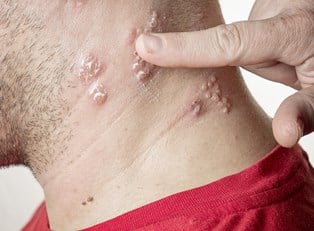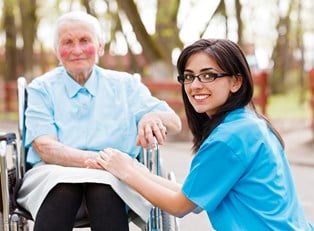Shingles (herpes zoster; zoster; or zona) is a painful, blistering skin rash, most commonly appearing as a band or stripe on one side of the body, due to the varicella-zoster virus, the same virus that causes chickenpox, which remains dormant in the nerve roots. Because it is a virus, shingles is incurable, though most individuals who suffer the illness only experience it once, without recurrence, and fully recover.
A shingles outbreak can be caused by high levels of stress, illness, or a compromised immune system. Anyone who has had chicken pox is susceptible to shingles, and those who have not had chicken pox, or been vaccinated for it, can contract it by coming into contact with a shingles outbreak. Shingles cannot otherwise be spread through touch.
Shingles usually clears within 2-3 weeks. Occasionally, one suffers a lasting pain called postherpetic neuralgia that can continue for months or even years. This happens when the nerves have been damaged during a shingles outbreak. This complication is more likely to occur in people 60 years of age or older.
Shingles Medical Treatment
There is no cure for shingles. Shingles treatment attempts to help minimize the pain, shorten the duration of a breakout, and reduce or eliminate complications. Earlier self-diagnoses of shingles leads to earlier treatment by a physician.
Shingles treatment may include antiviral medicines, such as Zovirax, Valtrex, and Famvir to boost the immune system for reduced pain and quicker recovery, as well as long-term medication including antidepressants, medicines for chronic pain, and topical skin creams. Ideally, medications should be prescribed within 24 hours of feeling pain or burning, preferably before the blisters begin to form, but long term damage and complications are greatly reduced if medicated within 72 hours. The drugs are usually given in pill form, in doses many times greater than those recommended for herpes simplex or genital herpes. Some individuals may be required to receive the medicine intravenously (through an I.V.).
Strong anti-inflammatory medicines called corticosteroids, such as prednisone, antihistamines and narcotics may be prescribed to reduce pain and swelling. Topical numbing agents such as lidocaine, can also reduce the pain and swelling caused by shingles.
Shingles Lifestyle and Home Treatment
Vigilant home care also greatly contributes to speedy and full recovery. Depending on the level of pain, one may not feel like doing much, in addition to feeling weak and tired. One should listen to his or her body and get plenty of rest, avoiding strenuous activity, during recovery. Avoiding stress is also important, as that may be one of the outbreak's causes, and it can intensify the pain. Relaxation techniques, like listening to music, reading a book, watching a movie, or working on a hobby are recommended to help take the mind off the pain. Keep any skin sores clean by taking a cool bath, or using cool, wet compresses on the blisters, which will also help ease pain and itching. Over the counter medications also may help.
Pain relievers such as ibuprofen (Advil) or naproxen (Aleve), anti-itch creme or calamine lotion, and oral antihistamines, like diphenhydramine (Benadryl) will go a long way toward increasing comfort during the shingles outbreak. The varicella-zoster vaccine (Zostavax) can help prevent shingles and is recommended for all adults aged 60 and older.



